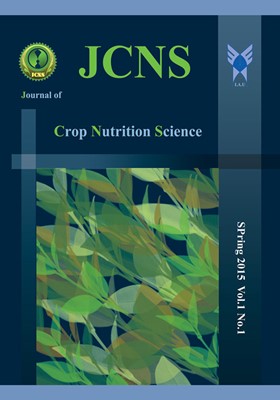-
-
List of Articles
-
Open Access Article
1 - Assessment of Terminal Heat Stress and Nitrogen on Grain Yield and Yield Com-ponents of Canola.
Ali Hamdi Shengri Aziz Karmollachaab Abdolmehdi Bakhshandeh Mohammad Hossain Gharineh Ghodratolah Fathi Faraj Saadi Al kasir -
Open Access Article
2 - Evaluation Amino Acids and Iron Nano particles on Photosynthetic Pigments and Yield of Potato
Arash Roozbahani Sanaz Pour Ali -
Open Access Article
3 - Effect of Different Levels of Nitrogen and Planting Patterns on Dry Matter Production and Growth Physiological Indices in Intercropping Maize and Sunflower
Seyed Nader Mosavian Seyed Alireza Seyed Mohammadi -
Open Access Article
4 - Effects of Foliage Removal and Using Different Nitrogen Rates on Remobilization of Pre-anthesis Assimilates to the Grain in a Dual-purpose (Forage and Grain) Barley
Adel Modhej Mani Mojadam Reza Mamaghani -
Open Access Article
5 - Evaluation of Tillage, Nitrogen Fertilizer and Crop Residue Management on some Agronomic Traits of Soybean
Alireza Safahani Maryamosadat Alavian Petroodi Farshad Ghooshchi -
Open Access Article
6 - Effect of Biological and Chemical Fertilizers on Yield and Yield Components of Some Maize Hybrids in South West of Iran (Shoushtar Region)
Ayeh Makvandi Mojtaba Alavifazel Shahram Lack -
Open Access Article
7 - Evaluation of Sulfur Fertilizer on Canola Yield under Salinity Conditions
Alireza Jafarnejadi Hamed Rezaei Ahmad Naderi -
Open Access Article
8 - Effect of Organic and Chemical Nitrogen Fertilizers on Grain Yield and Yield Components of Wheat and Soil Fertility
Syed Azam Shah Wisal Mohammad Syed Mahmood Shah Muhammad Shoaib Shafi -
Open Access Article
9 - Effects of Cadmium on Chemical Markers in Wheat (Triticum aestivum L.) Yield Production
Mohammad Reza Dadnia
-
The rights to this website are owned by the Raimag Press Management System.
Copyright © 2021-2025







